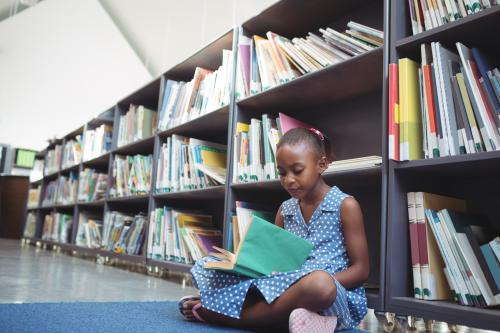In the spring of 2022, reports showed that only 67 percent of third graders were reading at grade level in the aftermath of the pandemic. Following on the heels of the recently released National Assessment of Educational Progress (NAEP) report, the U.S. now witnesses the largest decline in reading outcomes since 1980. Children from underserved communities have lost as much as half a year of traditional normal reading progress. Learning loss has become a well-worn term for an international crisis prompting governments to seek ways to accelerate learning.
This context has ignited a major reckoning with educational policy and methods. As it turns out, reading scores were not impressive even before the pandemic. According to the 2019 NAEP scores, just 34 percent of students were proficient at reading. By “proficient,” these scores suggest that students can only not just sound out a word, but also gain meaning from text. This low starting point pre-pandemic is the real problem. Someone, something, must be to blame. According to a recent New York Times article and a widely heard podcast, “Sold a Story,” Professor Lucy Calkins of Columbia University seems to be descending to that mantle.
The reading wars, it turns out, created a false dichotomy between meaning versus phonics as primary drivers of beginning—and later proficient—reading.
Professor Calkin’s balance reading curriculum was used in more than a quarter of U.S. schools. It focused on three cues that students needed to follow to become readers: semantics (is the word meaningful?), syntax (does the word fit grammatically?), and grapho-phonic (can you guess the sound from its first letter?). The bottom line is that this curriculum falls short. As “Sold a Story” reveals, balanced reading was an offspring of Marie Clay’s Reading Recovery program developed in New Zealand and used around the world. A report issued in April of 2022 noted that third and fourth graders who used reading recovery methods were behind those who did not use the program. Culprit revealed.
The science of reading has progressed a great deal in the 50 years since Reading Recovery and the balanced curriculum were introduced. Indeed, this period of scientific discovery can be seen as the end of the so-called reading wars between whole word instruction and phonics—or mastering the letter-to-sound correspondence that enables readers in an alphabetic system to translate print into language (i.e., that “b” translates into “buh”). Brain research helps to adjudicate that the winner of the reading wars was phonics. Professor Bruce McCandless of Stanford University found that children learning phonics activated the brain circuitry used in reading. Those who learned in whole-word methods did not.
Today, the brain circuitry underlying reading is well understood. Professor Stanislas DeHaene of the University of Paris is one of the leaders in this science. Reading, unlike speech, is a cultural phenomenon that must be learned. Professor Steven Pinker once said, “Children learn language in the way that spiders spin webs.” Reading does not work this way. Children need to visually recognize letters, combine the letters, and relate the sounds to the language and meaning systems in the brain. In fact, DeHaene argues that humans co-opted an area of the brain—the visual word form area—that matures as we get more experience in reading. That is, if children can sound out the words, they can tap into the vast resources of their language to glean meaning from print.
The bottom line is that children need to learn phonics and letters to sound out correspondence. Methods like Clay’s and Calkins, based on prior theories of whole-language reading, will not solve the problem. Calkin’s methods, as the podcast “Sold a Story” suggest, can generate readers who pretend to read rather than those who can actually read new words when encountered in print.
On the other hand, phonics alone, while necessary, will also not generate strong readers. A superbly written overview by Anne Castles and colleagues notes that children need to do more than translate letters into sounds: They need to make contact with a rich knowledge base and with a growing language system. In fact, educational methods that focused only on phonics had many children who sat in rows, barking out words for extended periods of time. Many of these children experienced the fourth-grade slump when their phonics knowledge did not translate into meaningful information. Jeanne Chall’s classic 2003 study suggested that the fourth grade slump results from the fact that students who have learned how to decode might not have the rich language base that they need to make meaning from the words that they sound out. Children need to learn in active and engaging ways that are meaningful and joyful.
The reading wars, it turns out, created a false dichotomy between meaning versus phonics as primary drivers of beginning—and later proficient—reading. The scientific answer is more nuanced. It takes both phonics and meaning to create strong readers. Phonics is the tool that allows children to break into the alphabetic system–to understand that the squiggles on the page relate to the words in their vocabularies. Meaning making is the key to finding richness in the narratives and the motivation for wanting to read.
U.S. student reading levels are low and have been low for decades. The pandemic exacerbated this serious educational problem. And this has prompted much reflection in education and in the public square. This is, however, an area in which the science is well developed.
We tend to oversimplify science when and if it moves from the laboratory to policy and classroom practice. Simplification comes at a cost. Even today, policymakers are pressed to understand that language and literacy are intertwined in all reading curricula moving forward. Let’s end the great disconnect between science, policy, and practice. Let’s teach reading in ways that support a foundation in phonics while making the experience enjoyable, motivating, and meaningful by connecting to children’s lived experiences. Let’s not confuse pedagogy with content. Phonics instruction need not be drilled into children but can be learned at the same time children are learning meaning and are actively involved.








Commentary
Why Jonny can’t read: The great disconnect between reading science and policy
December 19, 2022